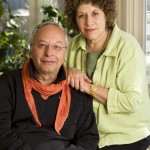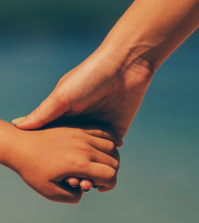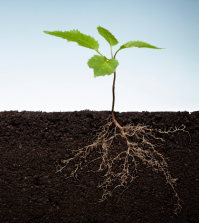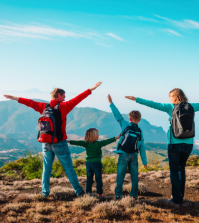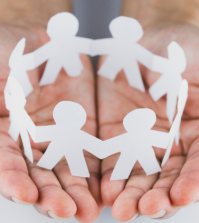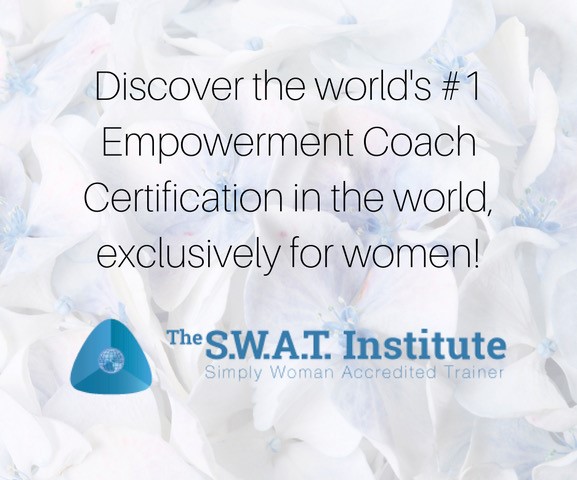- Mothering in a Fractured TimePosted 7 days ago
- Beneath the Surface: Revealing Life’s Goals nurtured from a Spiritual SeedPosted 1 week ago
- How We Kept Marital Peace while Traveling the World with Our KidsPosted 3 weeks ago
- How I Coped with Feeling Lost in a Changing SocietyPosted 3 weeks ago
- The Unexpected Liberation of a Butt DialPosted 2 months ago
- Why is France making abortion a constitutional right?Posted 2 months ago
We Are Not Alone Here

By Ed and Deb Shapiro
A monk asks, “Is there anything more miraculous than the wonders of nature?” The master replies, “Yes, your awareness of the wonders of nature.” Angelus Silesius
In the Buddhist teachings, there is a description of a huge net reaching in all directions with a multifaceted mirror-like jewel at each of the many knots, every jewel reflecting all the others. It is called the Jeweled Net of Indra and represents our interconnectedness: see one and you see all within it. Not one jewel can be separated from or is independent of any other; take one away and the net becomes unusable. In other words, we are interrelated, interdependent, inseparable, and interconnected all at the same time, part of an integrated whole, not separate from the trees, elephants, owls, our neighbors, the people in South Africa or a river in India. Caring for each other and the planet is, therefore, inseparable from caring for ourselves; we are both dependent on and a part of the earth and the woods and the children playing in the street, and they are a part of us. But living with this awareness takes some consideration, for our consensus reality is one of separation and isolation.
Jane Fonda:
“There are practical reasons for dividing everything up. It makes things easier to manage and to solve, especially technical matters: the us and them, the either-or, the man versus nature, mine and yours. Life is simpler to deal with. But we have applied this fragmenting mindset to all of life so that it has become our reality, which has led to further fragmentation and chaos and planetary destruction. The challenge is to figure out how to deal with our day-to-day life, while at the same time changing our mindset so that we see reality as the unbroken wholeness of the totality of existence, an undivided, flowing movement without borders.”
Bernie Glassman:
“Imagine that each of my two hands has the notion that it is an individual object and not connected to anything else. Left hand calls itself Sally, and right hand calls itself Harry. Then Sally gets cut. Harry has read many things about the oneness of life, but he believes that Sally is separate and thinks, I cannot do anything about Sally being cut, I am not a doctor, and I don’t have a first-aid kit. And anyway, I do not want to get my new clothes stained. Harry walks away, and Sally bleeds to death. But that means Harry also bleeds to death, as Harry and Sally happen to be very attached to each other. This is what happens when the experience of oneness is not there.
“Now imagine Sally and Harry both meditate and, while recognizing the separateness of Sally and Harry, they also recognize their oneness with Bernie. When Sally gets cut, Harry does the best thing possible to help her because he knows that to help her is also helping both him and Bernie. This is not a thinking process; it is the direct experience of the oneness of life. The appreciation of this is huge.”
Ajahn Sumedho:
“We are not isolated entities; we do affect each other. The more we experience this in meditation, the more we recognize how our own relationship to society need not be one of just being critical or putting up with or ignoring it, but of using our abilities, intelligence, and talents to serve each other. If I feel a sense of ‘me’ as a self-centered isolated being, then I will just think of my own immediate pleasure or needs and I have no relationship or sensitivity to anything else. But as I open to the truth of our connectedness, then I have a respect for all life; I no longer see others as just there for my own selfish exploitation.”
Tim Freke:
“We think that we are separate from each other and we are not. We think we are separate from the whole of life, and we are not. This belief makes us act as though we are only one part. But when we are awake to the fact that we are not just the part but really the whole, then we act to benefit the whole. Tim is an integral part of the whole, and everyone and everything are also an integral part of the whole and, therefore, one with Tim. Separateness is the conceptual story we tell to make sense of life, the story of who we are, and when we get sucked into it we are not conscious of our deeper being. This is when we cause suffering to each other and our world. Waking up is the recognition that there is no other, that every person or situation is not separate from our essential nature.”
Where separation divides and causes conflict, awareness of our interconnectedness means we see the other as ourselves. The jewels in Indra’s net are independent jewels and each reflects a different aspect of the whole, yet they are so interrelated that they cannot exist without each other or the entire net. At the same time, every jewel within the net is found reflected within each one.
Bernie Glassman:
“Take care of the person next to you. It might be your spouse, your child, your parents, or it might be a stranger. It doesn’t have to be big, it doesn’t matter who it is, and it doesn’t matter if they have nothing to give you; you just do it because it is there to be done. Meditation leads us to the experience of oneness. In that state, we automatically take care of everything we see because it is ourselves; it is not separate from us. We are walking down the street, and we see a person slip; it is not somebody else—we slipped. That is the bottom line for me: Once you take care of the delusion of separateness, then everything else is taken care of.”
Everything we think, say, and do has an immediate effect on everyone and everything else. This means that our thoughts and actions can lead to chaos and destruction as easily as they can lead to healing and friendship. It also means that we have enormous resources available to us at all times. “Do not make the mistake of thinking you are a powerless individual in a vast world,” writes Tai Situpa in The Way Ahead. “Know that you are armed with three great powers. You have the power of the body—the source of all action; the power of speech—the source of all expression; and the power of the mind—the source of all thought.”
Our actions, obviously, have the most direct impact on others. The destructive results of the belief that we are not connected and that, therefore, what we do has no bearing on others, is now being seen throughout our natural world. While we were in southern Egypt, we traveled by truck into the desert. From where the truck left us, we hiked far up a dry riverbed into silence and beauty and rubbish: piles of polystyrene and plastic dumped in the middle of nowhere. On an island in Greece, we found large bags of garbage washed ashore that had been tipped into the Mediterranean by passing boats; on the beach in Thailand, we watched local hotel owners burying their garbage in the sand. While in the exotic paradise of Sri Lanka, Deb was happily swimming in the beautiful Unawatuna Bay when human feces floated past her. Apart from polluting the land and water, such garbage and raw sewage is devastating to the surrounding plant, animal, and sea life. Every action we take, even the smallest and simplest of everyday choices, has a consequence.
Marc Ian Barasch:
“Nothing exists by itself; everything exists only in relationship. This leads to the realization that life is not just about my own
Marc Ian Barasch:
“Nothing exists by itself; everything exists only in relationship. This leads to the realization that life is not just about my own. Everything exists in relationship. Maybe it is better to apply elbow grease to pots, even though it does not make us so blissfully happy!”
We can only misuse the world when we believe that we are independent from it or are in some way superior to it. Yet no action is independent of its effects. We see this particularly in our immediate environment where every creature, insect, tide, or weather pattern has its own unique role to play as an integrated part of the greater whole. Nothing is without a purpose. If we do not understand this, then we easily abuse it.
Mark Mawrence:
“Environmentalism and ecology are teaching us how everything is connected. The environment wastes nothing. It disposes of hundreds of billions of tons of fallen leaves and decaying materials, recycling them in an elegant and beautiful system. Whereas we, in this modern world, waste everything. We excrete hundreds of billions of tons of toxins into the environment, causing the impact that we are all familiar with. Eskimos in Alaska are breathing lead from fumes emitted in Los Angeles. Farming cycles in Hawaii and Central America are impacted by smog created in China. Once we establish that connectedness between us all, whether we live in Boise, Idaho, or Tokyo, we see how everything we do impacts each other.”
Our neighborhood is our shared home, and our environment is our shared garden. Picking up rubbish is not just an act of kindness to our eyes, but also so we do not clog our rivers or seas; fighting to save the rainforests is not just so the trees can survive, but also that we may breathe more easily.
Just as ignorance creates ignorant actions, so skillful awareness can generate a more positive outcome. Meditation is one of the most skillful of all actions. Although sometimes labeled as being a self-absorbed, if not selfish, activity, it not only changes our own behavior by increasing our awareness, but in turn we then influence and can change the world around us.
Tami Simon:
“The effect of meditation is a rewiring of priorities. These are the priorities of our relationship with the earth and other people and how our heart is doing on any given day. The earth is what we are, what are bodies are; we are the same as the soil and the trees. The people we live with, who we wake up next to, who we sit across the dinning room table from, the people we work with every day—these are the relationships that should be our priority. When those things become our priority, we will make all kinds of different decisions as a global world.”
The impact of our words is less obvious than that of our actions, but they are just as effective. Words are heard and felt; they reverberate throughout our system, affecting those who hear them and causing either joy or conflict. They can start wars or mend hearts. As such, they should not be used lightly, but with consideration of their influence.
Joseph Goldstein:
“We need to understand our own minds. We need to see our own patterns and expressions. In a way it is so obvious. If we are full of judgment or anger or fear, we are just contributing to the problem. And if we let judgment go and become more loving and accepting and compassionate in ourselves, then that is what we give to the world.”
Thoughts may be subtler, but when used purposefully, they are equally powerful. From our thoughts are born our words and our actions; they influence our behavior and beliefs, who we care for and who we dismiss. They also influence the unseen and unknown as we send our thought waves and energy out into the universe. It is our responsibility, therefore, to ensure that these thoughts are positive and creative ones.
To know that we are all interconnected and a part of each other is not always enough; we also need to experience this in a living, vibrant way. One way to do this is by being outside. So many of us have lost touch with nature, yet just taking time to sit in a city park can reconnect us to the life with which we share our world. If we meditate on our shared connectedness, and we do this outside, we will move from the confines of the ego-self into the wholeness that surrounds us. And when we let nature communicate with us, we discover there is much we can learn.
John Milton:
“The process of meditating outdoors in nature allows us to become very quiet and still. But at the same time, we begin to experience a deep communion with other living beings. We begin to actually have the experience of not being defined just as an individual being, separate from the rest of life, but as a being that is totally interwoven and interconnected with all life. Such meditation is appropriate for these times as we are so out of touch with the rest of life, which has led us to the point where our relationship with the planet itself is threatened. I think it is more that we are in peril, rather than nature. Our own capacity to really experience the deep joy that comes from being a part of all life is the most endangered thing that we face.
“If we only do our meditation practice in buildings, in human-constructed places, then we do not have that primordial connection to nature that is so needed. The vision quest that is found in many different traditions is probably one of the oldest spiritual practices on the planet. This is the process of going alone into nature for a period of time to embrace the great mystery in solitude, to have a deeper experience of the truth beyond our built-up world. When we do vision quests or sacred path solos, we focus on meditating with each perception, with sight, smell, taste, and touch: We see what is all around us, we smell the richness of the earth, we reach out to touch our world. By meditating with these perceptual fields, we have an experience of communion with the great mystery, with the sky and the trees and the earth beneath our feet.”
In this same way, the Native American people, as with many other native peoples around the world, live in harmony with and are intimately connected to the earth. Because their lives are so much a part of their environment, they have a natural reverence for it and have integrated a deep awareness of how nature works into the way in which they live.
The awareness of nature is also an awareness of the sacred and of the necessity of bringing the sacred into every part of our lives. We rarely talk about things being sacred—our daily life seems far too mundane in comparison, and so the subject is normally relegated to the more unreachable aspects of religion. Yet the sacred can be found in every moment; it simply needs our awareness and recognition.
Sarasvati Burhman:
“Clearly our history of political and economic support for capitalism has played a major role in our present environmental problems. But there is individual responsibility too, and here I do not just mean our failure as individuals to recycle, carpool, or monitor our water consumption. We live in these bodies that are expressions of nature, yet we fail to comprehend the sacredness of all life. We treat other living beings as little more than commodities for our consumption. Once I asked a Hindu villager why the cow was sacred in Indian culture. He replied that the bull plows the fields and the dung is used as fuel for fires. The cow gives milk, yogurt, and butter for food and medicines. How could something that gives so much not be sacred? Then he asked me, ‘How can we return such generosity by killing?’
“In ancient Celtic spirituality, trees were regarded as sacred beings. If we reflect on it, we see that they are like the cows of the plant world, providing so much that is necessary for other life forms on our planet, not the least of which is the oxygen we breathe. Their fruits and nuts provide food for us without requiring any violence on our part. Is it right to so mindlessly destroy them as we do? A person who meditates for a period of time in a forest begins to feel the same universal consciousness emanating from all living beings. Such an experience.
To recognize the sacred is to appreciate all things as they are, to see the beauty inherent in everything from a doorknob to a moonlit river, from the preciousness of life to the magnificence of its unfolding. There is an old Tibetan story about a blind turtle that lives in the ocean and comes to the surface only once every thousand years. A gold ring floats in the ocean. The story goes that the chance that the blind turtle will put its head into the ring when it comes up for air is as rare as it is for a human to take birth. This story is told in order to emphasize how precious our life really is.
In meditation, as we watch thoughts move through our mind, or watch aches and pains come and go, we are witnessing how all things are temporary and insubstantial. This awareness can generate tremendous gratitude for what is here now, just as it is. Yet it is easy to forget to appreciate what we have and to put our happiness on hold. We make gratitude something we will come to some time in the future: When things are better, when our children get married, when the weather changes, when we have more money, then we will be grateful. So much time is wasted waiting to be happy, when all we need to do is experience the magnificence of what we already have.
For instance, take a moment right now to appreciate the chair you are sitting on as you read this. Consider what went into the making of this chair: the wood, cotton, wool, or other fibers, the trees and plants that were used, the earth that grew the trees and plants, the sun and rain, the animals that were involved and maybe gave their lives, the people who prepared the materials, the factory where the chair was made, the designer and carpenter and seamstress, the shop that sold it—all this just so you could be sitting here now. You can include the building you are in or the clothes you are wearing and all the elements involved in their making.
Or think of your body and all the different organs and functions and systems that sustain your life, such as your heart, digestion, or your immune system that protects you from illness. Or think of the food that nourishes you and where it came from and all the people and plants and weather and transport that were needed to get that food on your table. It is so huge; there is no beginning place.
There is just an endless stream of connectedness that has come together to enable you to be here right now, in this moment, reading this, sitting on a chair. And we think we have nothing to feel grateful for or worth appreciating?
We can develop an attitude of gratitude by making a list of things to remember to appreciate. We can do this hourly, daily, or weekly, finding different things to appreciate each time. Anything can go on that list: pets, people, grapefruit, flannel sheets, clean water, sunshine. . . . Then say, “Thank you!” Say it out loud, and again. We can never have enough gratitude; let it fill every moment, every thought, and every feeling.
Appreciating nature, honoring the world around us, and recognizing the sacredness of all life are essential for our survival, but we also have to act. Given all the environmental difficulties we are facing, such as pollution, climate change, and the loss of biodiversity, we may not have too much time to make the changes that are needed.
Marianne Williamson:
“We are like the Titanic headed for an iceberg. If we continue with the behavioral patterns that now dominate our relationship to the earth and its resources, it is said that we only have fifty years before the planet will be overrun with something like 200 million environmental refugees, and if you have this kind of a situation on the planet, then human suffering will be immeasurable. Our job is to move from probabilities to possibilities, and the only way we can do this is if enough of us, within our own minds and our own hearts and our own lives, reach a state of consciousness that moves us out of the time-and-space continuum as we now experience it. We are at the eleventh hour, and somehow we have to expand this hour, and that can happen when we meditate.”
As we recognize what we have done to our planet and we see the work that needs to be done to put it right, we may feel either overwhelmed and incapable or desperate to try and fix it all at once. But, as the saying goes, “We can only do it one person at a time.” Taking time to meditate may seem irrelevant when we are confronted with the need for so much action; it is easy to think that meditation has nothing to do with saving the world, that it is just something we do for ourselves. Yet the combination of action and meditation is essential.
Ed Begley, Jr.:
“There is so much work to do that we say, ‘Oh, we have got to save it right now, the whales are dying, we can’t leave the dolphins, and look the rivers are so polluted, we have got to do something, come on—let’s move, I can’t sleep tonight, I have got to drink some coffee and get up for that rally tomorrow, we have to save the environment, it’s so terrible.’ Although we are not going to solve all the problems by just sitting on the side of a hill or by spinning a prayer wheel, we also have to be still and centered so we can act with clarity. In other words, in order to do this work, we need to have an inner resource we can always come back to. If we do not have quiet time, we will get too burnt out to be able to clean up the rivers or save the whales. We have to sit still and recharge. We have to be in the moment as it is happening, and we cannot do that if we do not have mediation as a resource.”
Beyond being an essential resource, meditation also provides the spaciousness necessary to find new and creative answers to difficult problems. Searching for solutions can be an endless occupation, but times of quiet reflection will feed our inspiration and insight, making our choices of action more sustainable and balanced.
Mark Mawrence:
“I was asked by the mayor to serve on the board of directors of the Bay Street district, a non-profit corporation that manages the entire downtown area. We had an enormous crisis as homeless people were flocking here due to all the foot traffic. The pedestrians made for lots of easy targets along the sea front, and the promenade was almost shut down because we were getting hundreds of complaining letters a week, there were articles in the newspapers about all the homeless people with panhandlers accosting citizens, driving away diners, scaring children, and on and on. The mayor asked me if I could fix the problem. He said, ‘Please, could you do something, Mark? You’re an out-of-the-box thinker. Please do something.’
“I held hearings. I listened to the homeless groups, I listened to neighborhood groups, and I listened to the police and city agency workers. Basically, everybody ended up screaming at each other. The activists would say if the homeless want to urinate on themselves and die in a shop doorway, it is their right and no one should ever stand in between them and their right to do that. Then the opponents would say let’s rent buses, put a nice buffet on the buses, lure the homeless onto the buses, and drive them out of town. We had this very typical split: tolerance versus toughness.
“The mayor wanted a report and I had no idea what to do, so I decided to do my second most favorite form of meditation next to sitting: I went surfing. I experience surfing as a very powerful meditation as I am not only fully present and aware of every moment, but I also enter into the sound of the sea, become one with the waves and go beyond thinking. In those thoughtless moments, creativity often stirs with solutions to any difficulties I am dealing with.
“I sat on my board and let all of the screaming go out of my mind. I did not think about the problem; I was there to rest my thinking and just be silent. I was floating quietly, letting the waves lull my mind, when two dolphins jumped out of the water right in front of me. It was awesome! And it was as if the dolphins jumped into my mind, which was completely open and receptive. In that moment, I immediately knew what to do.
“Long story short, I raised about $350,000 to forge life-size bronze dolphin sculptures. Where the blowhole should be is a little coin slot to put money. Everyone is encouraged to give to the dolphins, rather than giving to the homeless. The money the dolphins collect feeds the hungry, it clothes the homeless, it puts people up, it pays for shelters for abused women, it does job training, and it gives medical treatment to the needy. All the homeless charities are now supported by the dolphins.”
We watched as an eager young television reporter from CNN asked the Dalai Lama what was the first thing he thought of when he awoke in the morning. We thought that this most revered teacher would say something deeply profound or insightful, something along the lines of vowing to save the world from its own ignorance. Instead, he simply replied, “Shaping motivation.” He said that we all, including himself, have to be vigilant so that our intentions are focused in the right direction. He said that shaping his motivation on a daily basis constantly reminds him to extend loving kindness and compassion to all others. Such motivation extends us beyond ourselves so that we are not limited by a lack of confidence or self-esteem.
It is easy to underestimate ourselves or to think that one person really does not make a difference. But even small gestures or acts can have a very big impact—consider how much of an effect a single mosquito can have! Each one of us has something special and unique to offer, and even more so when we are in touch with our essential interrelatedness. We can each act to leave the world a better place than we found it.
Jon Kabat-Zinn:
“The world needs all its flowers. Sometimes we may think, Well, I am not a flower, I am not beautiful, and I don’t have any qualities that might be useful. What a hubris that is, to think the world has singled you out to be useless and unbeautiful! It is very important to ask, ‘What can I do that would contribute even in the tiniest way to greater levels of well-being and sanity and kindness on the planet?’ Even the act of taking your seat for meditation is a radical act of love that extends way beyond your small self.
“Individually and collectively, we are not paying appropriate attention to our experience as human beings. The consequences of this are dire and potentially disastrous for the world. We are ignoring certain aspects of reality in favor of others, and it creates huge amounts of suffering. The cause of that is really a certain kind of conditioning that is driven by small-mindedness or an identification with who we think we are, as opposed to a much bigger direct experience of the unboundedness of human nature.”
Motivation guides our behavior and determines whether our intent is arising out of selfishness or selflessness. Is our motivation one of kindness, forgiveness, or letting go? Or is it one of judgment, blame, or grasping? Are we making someone else seem wrong in order for us to appear right? Are we ignoring or dismissing someone? Or are we genuinely concerned, genuinely feeling consideration, respect, and care? If we take each situation into our meditation, then we can ask, ‘What is the deeper intention of my behavior? What is my real motivation?’ We need to question our actions, words, and thoughts in this way so that we can answer the call of the world.
Andrew Harvey:
“Meditation is an essential part of the solution to the really immense crisis that we are in, because this crisis demands of us that we are able to see the extent of the damage that we have done to ourselves and to the earth and start working with fully motivated wills and hearts in the world. None of that can be done without meditation. But meditation must also have a vision of action with a passionate commitment to service, to really do something about the issues that are now afflicting our future. Meditation without vision would be absolutely empty, while action without the knowledge, wisdom, passion, and love gained from meditation is useless. We need the clarity of meditation to awake our motivation.”
Letting go of insecurities and self-doubt so that we can be available and open to what is needed in the moment are qualities that we can bring not only to our meditation but to our communication with others and to situations in the world. The only limits to what we can do are the ones we impose on ourselves.
Jean Houston:
“Meditation gives us access to the vastness of the universe. Our challenge is to take this understanding and reinvent our civilization, including agriculture, education, and economics, with an intelligent self-organizing living universe. Instead of degrading the universe’s life systems, we must now learn to join all beings together in a mutually enhancing manner. Meditation gives us the awareness to do this as consciousness becoming self-conscious.”
*********
Ed & Deb are the authors of The Unexpected Power of Mindfulness & Meditation and The Art of Mindful Relaxation. Deb is the author of Your Body Speaks Your Mind, now in 19 languages. See more at EdandDebShapiro.com


